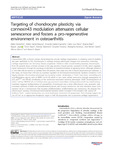Targeting of chondrocyte plasticity via connexin43 modulation attenuates cellular senescence and fosters a pro-regenerative environment in osteoarthritis

View/
Use this link to cite
http://hdl.handle.net/2183/23017Collections
- Investigación (FIC) [1687]
Metadata
Show full item recordTitle
Targeting of chondrocyte plasticity via connexin43 modulation attenuates cellular senescence and fosters a pro-regenerative environment in osteoarthritisAuthor(s)
Date
2018-12-05Citation
VARELA-EIRÍN, Marta, et al. Targeting of chondrocyte plasticity via connexin43 modulation attenuates cellular senescence and fosters a pro-regenerative environment in osteoarthritis. Cell death & disease, 2018, vol. 9, no 12, p. 1166.
Abstract
[Abstract] Osteoarthritis (OA), a chronic disease characterized by articular cartilage degeneration, is a leading cause of disability and pain worldwide. In OA, chondrocytes in cartilage undergo phenotypic changes and senescence, restricting cartilage regeneration and favouring disease progression. Similar to other wound-healing disorders, chondrocytes from OA patients show a chronic increase in the gap junction channel protein connexin43 (Cx43), which regulates signal transduction through the exchange of elements or recruitment/release of signalling factors. Although immature or stem-like cells are present in cartilage from OA patients, their origin and role in disease progression are unknown. In this study, we found that Cx43 acts as a positive regulator of chondrocyte-mesenchymal transition. Overactive Cx43 largely maintains the immature phenotype by increasing nuclear translocation of Twist-1 and tissue remodelling and proinflammatory agents, such as MMPs and IL-1β, which in turn cause cellular senescence through upregulation of p53, p16INK4a and NF-κB, contributing to the senescence-associated secretory phenotype (SASP). Downregulation of either Cx43 by CRISPR/Cas9 or Cx43-mediated gap junctional intercellular communication (GJIC) by carbenoxolone treatment triggered rediferentiation of osteoarthritic chondrocytes into a more differentiated state, associated with decreased synthesis of MMPs and proinflammatory factors, and reduced senescence. We have identified causal Cx43-sensitive circuit in chondrocytes that regulates dedifferentiation, redifferentiation and senescence. We propose that chondrocytes undergo chondrocyte-mesenchymal transition where increased Cx43-mediated GJIC during OA facilitates Twist-1 nuclear translocation as a novel mechanism involved in OA progression. These findings support the use of Cx43 as an appropriate therapeutic target to halt OA progression and to promote cartilage regeneration.
Keywords
Connexin43
Osteoarthritis
Chodrocity plasticity
Cartilage regeneration
Osteoarthritis
Chodrocity plasticity
Cartilage regeneration
Editor version
Rights
Atribución 3.0 España
ISSN
2041-4889






